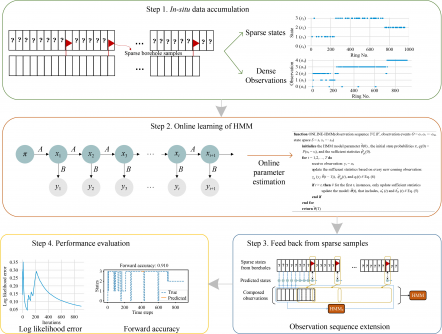Science
New Model Enhances Geological Risk Prediction in Tunnel Excavation

In a significant advancement for tunnel construction, researchers have developed a new method to predict geological risks with greater accuracy. The study, titled “Geological Risk Prediction Under Uncertainty in Tunnel Excavation Using Online Learning and Hidden Markov Model,” introduces the online hidden Markov model (OHMM), which combines online learning techniques with the traditional hidden Markov model to mitigate risks associated with geohazards such as collapses, water inrush, and landslides.
Conducted by a team from Huazhong University of Science and Technology and Nanyang Technological University, the research addresses the limitations of conventional geological data collection methods. Traditional approaches, including borehole logging, can provide accurate data but are often invasive and suffer from limited sampling rates. Non-invasive techniques, while offering higher spatial resolution, struggle with accuracy due to measurement errors and signal processing challenges.
Innovative Approaches to Geological Risk Assessment
Conventional machine learning models, such as long short-term memory (LSTM) networks and support vector machines (SVM), typically rely on large amounts of pre-existing data. However, tunnel construction projects generate data incrementally over time, complicating the prediction of geological risks. The OHMM addresses this issue by adapting to new data as it becomes available, effectively managing uncertainties that often arise during excavation.
The research team incorporated an observation extension mechanism, utilizing pre-construction borehole samples. This approach allows for the extension of short sequences of observed data to create a complete dataset that characterizes the geological risk in the excavation area. The effectiveness of the OHMM was validated through a case study on a tunnel excavation project in Singapore, which involved 915 rings.
In performance comparisons, the OHMM outperformed traditional methods, including standard HMM, LSTM, neural networks, and SVM. It demonstrated a remarkable ability to predict geological risks ahead of the tunnel boring machine (TBM). For instance, with only 300 observed rings, the OHMM achieved a forward prediction accuracy of 0.968. Even with 600 observed rings, it maintained an accuracy of 0.902. This performance significantly surpasses that of other models in predicting geological conditions in unexcavated areas.
Practical Implications for Tunnel Excavation
Notably, the OHMM showed consistent predictive capabilities for up to 100 rings ahead. To balance prediction accuracy and stability, the researchers recommend a foresight distance of 30 rings for practical guidance during tunnel excavation. These advancements are critical for enhancing safety and efficiency in tunnel construction projects, ultimately reducing the risk of costly delays and accidents.
The full research paper authored by Limao Zhang, Ying Wang, Xianlei Fu, Xieqing Song, and Penghui Lin is available for further reading at this link.
-

 Technology5 months ago
Technology5 months agoDiscover the Top 10 Calorie Counting Apps of 2025
-

 Health2 months ago
Health2 months agoBella Hadid Shares Health Update After Treatment for Lyme Disease
-

 Health3 months ago
Health3 months agoErin Bates Shares Recovery Update Following Sepsis Complications
-

 Technology4 months ago
Technology4 months agoDiscover How to Reverse Image Search Using ChatGPT Effortlessly
-

 Technology1 month ago
Technology1 month agoDiscover 2025’s Top GPUs for Exceptional 4K Gaming Performance
-

 Technology2 months ago
Technology2 months agoElectric Moto Influencer Surronster Arrested in Tijuana
-

 Technology5 months ago
Technology5 months agoMeta Initiates $60B AI Data Center Expansion, Starting in Ohio
-

 Technology5 months ago
Technology5 months agoRecovering a Suspended TikTok Account: A Step-by-Step Guide
-

 Health4 months ago
Health4 months agoTested: Rab Firewall Mountain Jacket Survives Harsh Conditions
-

 Lifestyle5 months ago
Lifestyle5 months agoBelton Family Reunites After Daughter Survives Hill Country Floods
-

 Technology4 months ago
Technology4 months agoHarmonic Launches AI Chatbot App to Transform Mathematical Reasoning
-

 Technology3 months ago
Technology3 months agoUncovering the Top Five Most Challenging Motorcycles to Ride









